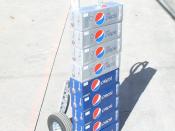Effective communication between an organization and its publics is key component of crisis management. Organizations must see the importance of releasing the right information to both internal and external publics to minimize negative publicity and negative public reaction. In today's marketplace organizations have to make a concerted effort to manage a crisis situation or inevitably the media will. A crisis such as the Pepsi Case Study: There's a Syringe in My Pepsi Can! can and will interrupt the flow of an organizations business.
The intent of this paper is to evaluate the effectiveness and impact of communication between the PepsiCo and the organizations intended publics, differentiate between those internal and external publics, evaluate the benefits and risks of the communication tools used, and determine the impact of new technologies were this crisis to happen in today's global environment.
Case OverviewIn June of 1993, PepsiCo found itself facing a widespread news story claiming that foreign objects were being found in unopened cans of Diet Pepsi.
On June 9, 1993, a couple from Tacoma, Washington claimed they found a used syringe in a half-empty can of Diet Pepsi. The can was turned over to their lawyer, whom promptly contacted the health department. The story, initially picked up the following day by one local news station confirmed no reports of injury but did cite the Sudafed tampering case from a few years ago and that needles aroused concerns of AIDS. On June 12, 1993 another claim of finding a needle was made in Washington. Local media picked up the story and on June 12, 1993 the FDA issued a five-state consumer alert. The FDA did not recommend a recall, but did advise consumers to pour soft drinks, particularly Diet Pepsi, into a cup prior to consumption. Next, another claim of a syringe in...


